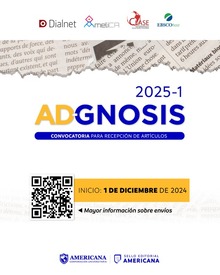Redes invisibles: El poder de los grupos informales en las organizaciones comerciales de Aguas Verdes, Perú
DOI:
https://doi.org/10.21803/adgnosis.14.16.969Palabras clave:
Comportamiento organizacional, Comunicación informal, Liderazgo, Relaciones laboralesResumen
Introducción: En el distrito fronterizo de Aguas Verdes, región Tumbes, Perú, las organizaciones comerciales operan en un contexto de alta informalidad laboral y débil institucionalización, lo que favorece la formación de grupos informales como mecanismos de cohesión y coordinación. Objetivo: analizar la presencia y configuración de estos grupos en función de variables sociodemográficas y laborales, considerando tres dimensiones: liderazgo informal, comunicación interna y cohesión grupal. Metodología: El estudio, de tipo descriptivo y enfoque cuantitativo. Se aplicó un cuestionario estructurado con escala Likert de cinco puntos a 450 trabajadores. El instrumento presentó alta confiabilidad (α = 0.825 en promedio) y validez convergente (AVE > 0.50). Resultados: el 55 % de los encuestados percibe un nivel medio de presencia de grupos informales, el 26 % un nivel alto y el 19 % un nivel bajo. Asimismo, la prueba de Kruskal-Wallis (H = 235.377; p < 0.05) mostró diferencias significativas entre las categorías analizadas, evidenciando que las características sociodemográficas influyen en la dinámica de los grupos informales. Conclusión: estos grupos desempeñan un papel esencial en la comunicación, liderazgo y cohesión.
Descargas
Referencias
Boerma, S., de Laat, M., & Vermeulen, M. (2024). The relationship between organisational agility and informal learning. Management Review Quarterly. https://doi.org/10.1007/s11301-024-00460-x
Capone, F., & Lazzeretti, L. (2018). The different roles of proximity in multiple informal network relationships: evidence from the cluster of high technology applied to cultural goods in Tuscany. Industry and Innovation, 25(9), 897–917. https://doi.org/10.1080/13662716.2018.1442713
Denner, N., Koch, T., Viererbl, B., & Ernst, A. (2025). Feeling connected and informed through informal communication: a quantitative survey on the perceived functions of informal communication in organizations. Journal of Communication Management, 29(1), 71–93. https://doi.org/10.1108/JCOM-06-2024-0085
Ding, H., & Rigby, J. (2011). An Investigation on the Relationship between Informal Networks and Organizational Performance (pp. 490–493). https://doi.org/10.1007/978-3-642-21660-2_55
Ejaz, H., Shafique, I., & Qammar, A. (2024). Improving Team Adaptive Performance Through Team Cohesion: An Integrated Team Level Framework. South Asian Journal of Human Resources Management. https://doi.org/10.1177/23220937241306216
Forsyth, D. R. (2021). Recent advances in the study of group cohesion. Group Dynamics: Theory, Research, and Practice, 25(3), 213–228. https://doi.org/10.1037/gdn0000163
García-Valenzuela, V. M., Jacobo-Hernandez, C. A., & Flores-López, J. G. (2023). Dynamic Capabilities and Their Effect on Organizational Resilience in Small and Medium-Sized Commercial Enterprises. Management & Marketing, 18(4), 496–514. https://doi.org/10.2478/mmcks-2023-0027
Granovetter, M. S. (1973). The Strength of Weak Ties. American Journal of Sociology, 78(6), 1360–1380. https://doi.org/10.1086/225469
Homans, G. C. (1958). Social Behavior as Exchange. American Journal of Sociology, 63(6), 597–606. https://doi.org/10.1086/222355
Jin, X., Yang, D., Sun, W., & Xu, L. (2025). Building a Resilient Organization Through Informal Networks: Examining the Role of Individual, Structural, and Attitudinal Factors in Advice-Seeking Tie Formation. Systems, 13(4), 245. https://doi.org/10.3390/systems13040245
Krackhardt, D. (1990). Assessing the Political Landscape: Structure, Cognition, and Power in Organizations. Administrative Science Quarterly, 35(2), 342. https://doi.org/10.2307/2393394
Krackhardt, D., & Stern, R. N. (1988). Informal Networks and Organizational Crises: An Experimental Simulation. Social Psychology Quarterly, 51(2), 123. https://doi.org/10.2307/2786835
Lee, Y. G., & Choi, J. N. (2025). Informal networks and information environments. Strategic Management Journal, 46(5), 1120–1148. https://doi.org/10.1002/smj.3686
Leino, T. (2022). Informal Leadership: An Integrative View and Future Research. VAKKI Publications, 14(1). https://doi.org/10.70484/vakki.149330
Luria, G., & Berson, Y. (2013). How do leadership motives affect informal and formal leadership emergence? Journal of Organizational Behavior, 34(7), 995–1015. https://doi.org/10.1002/job.1836
Marqués Sánchez, P., González Pérez, M. E., Agra Varela, Y., Vega Núñez, J., Pinto Carral, A., & Quiroga Sánchez, E. (2013). El análisis de las redes sociales: Un método para la mejora de la seguridad en las organizaciones sanitarias. Revista Española de Salud Pública, 87(3), 209–219. https://doi.org/10.4321/S1135-57272013000300001
Mena De la cruz, A. M., García Vargas, Ó. H., & Zapata Domínguez, Á. (2021). Caracterización de los vínculos en la organización informal de una Institución de Educación Superior. Cuadernos de Administración, 34. https://doi.org/10.11144/Javeriana.cao34.cvoiies
Ministerio de Trabajo y Promoción del Empleo. (2021). Tumbes - Diagnóstico Socioeconómico Laboral - 2021. https://cdn.www.gob.pe/uploads/document/file/2506245/Tumbes%20-%20Diagn%C3%B3stico%20Socioecon%C3%B3mico%20Laboral%20-2021.pdf
Sultana, N., Rahman, M. M., & Khanam, R. (2022). Informal Sector Employment and Economic Growth: Evidence from Developing Countries in SDG Perspective. Sustainability, 14(19), 11989. https://doi.org/10.3390/su141911989
Van den Berg, B. J. (2025). Leadership Without Limits: The Relevance of Self-Leadership and Informal Leadership. Journal of Leadership and Governance, 4(1). https://doi.org/10.58425/jlg.v4i1.315
Vanegas-Chinchilla, N., González Salazar, N., & Montoya Hernández, A. (2023). El estudio de las organizaciones en economías informales: conceptos, antecedentes y perspectivas futuras. Innovar, 33(90), e111449. https://doi.org/10.15446/innovar.v33n90.111449
Vanhala, M., & Tzafrir, S. S. (2021). Organisational trust and performance in different contexts. Knowledge and Process Management, 28(4), 331–344. https://doi.org/10.1002/kpm.1681
Wu, H., & Lv, H. (2024). A meta-analysis on social exchange relationships and employee innovation in teams. Humanities and Social Sciences Communications, 11(1), 1555. https://doi.org/10.1057/s41599-024-04101-2
Yahiaoui, D., Jiang, C., Stokes, P., Pereira, V., & Sinha, P. (2025). The role of informal networks in shaping specific HRM practices in emerging markets: evidence from the wasta and guanxi context. The International Journal of Human Resource Management, 1–33. https://doi.org/10.1080/09585192.2025.2505578
Zhu, E., Li, W., Zhao, C., & Wang, J. (2024). Promoting the Sustainable Development of Enterprises: Unraveling the Dual Impact of Informal Communication on Employee Affect and Problem-Solving Capabilities. Sustainability, 16(13), 5710. https://doi.org/10.3390/su16135710

Descargas
Publicado
Número
Sección
Licencia
Derechos de autor 2025 Ad-Gnosis

Esta obra está bajo una licencia internacional Creative Commons Atribución-NoComercial-SinDerivadas 4.0.





